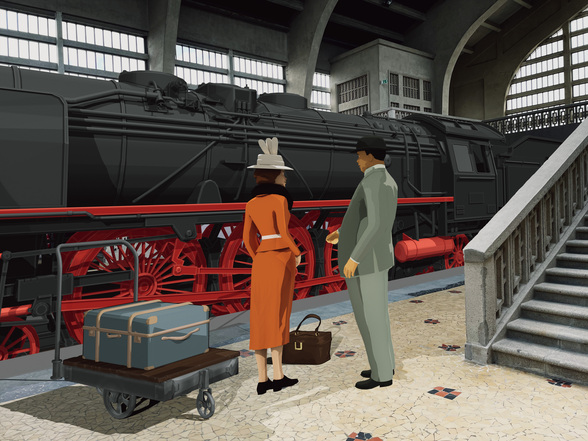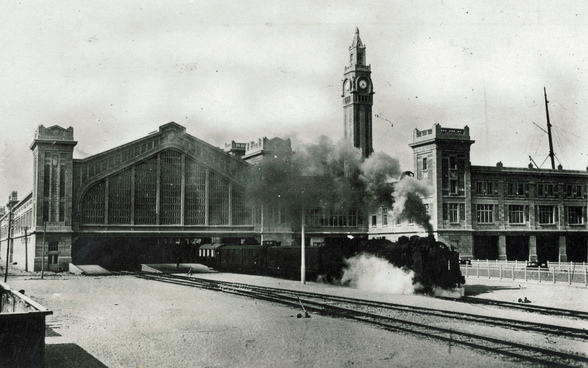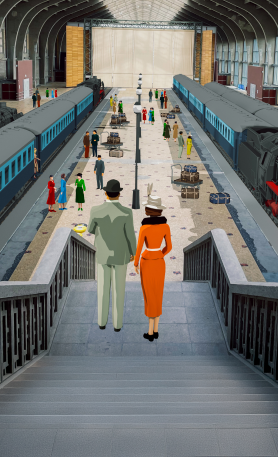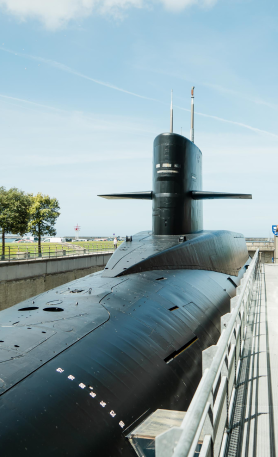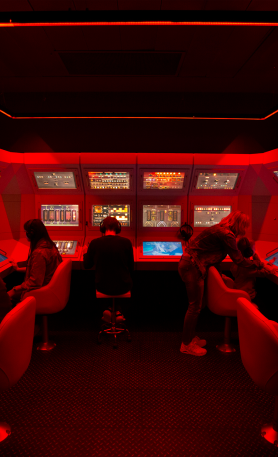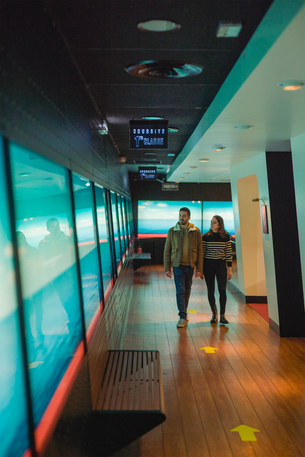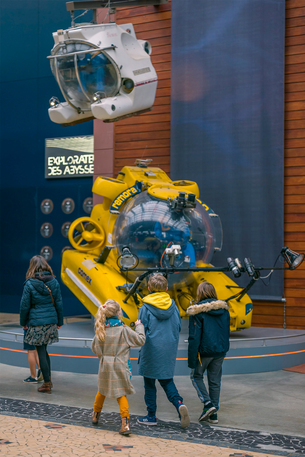Travel back in time
Discover Europe’s last Art Deco Gare Maritime Transatlantique with a mixed reality headset. In the heart of the former train hall, you can relive the excitement of a historic day in Normandy: the Queen Mary’s first port call at Cherbourg, on April 14, 1937.
In this historic building, listed on the supplementary inventory of historic monuments, you’re surrounded by transatlantic trains and passengers dreaming of crossing the ocean to America. You walk in the footsteps of passengers ready to board the latest Cunard liner.
During your 35-minute tour, you’ll meet a host of witnesses to the era, including the station’s architect and decorator, a baggage handler, members of a jazz band, a shipping company employee and travelers eager to discover the Queen Mary.
Available very soon – Opening scheduled for spring 2025
A visit in mixed reality
On arrival, you are fitted with a mixed-reality headset. Thanks to a camera, you can see the environment in which you are standing: the Grande Halle of Cherbourg station, which in 1933 was described by the press as “the most beautiful maritime station in the world”. Digital images are superimposed in real time, immersing you in the atmosphere of the 1930s.
Push open the doors of the large Reception Nave and discover the imposing architecture of Cherbourg’s Gare Maritime Transatlantique. Inaugurated on July 30, 1933, the Gare Maritime Transatlantique was considered the largest French construction after Versailles…
Built to accommodate the largest ocean liners of the era, “Notre Dame des Queens” housed a Transatlantic Hall measuring 280 meters long by 42 meters wide, including the Sous Douane rooms, the Pas Perdus rooms, the company offices and the various services and stores available to passengers; and a Train Hall measuring 240 meters long by 40 meters wide, with three platforms serving four tracks directly connected to the Paris/Cherbourg rail line. A Voie Charretière 280 meters long and 15 meters wide separates these 2 halls.
Since the end of the 19th century, many men and women have tried their luck in the New World.
Between 1900 and 1914, Europe witnessed a second wave of migration, mainly from Central Europe. In addition to the economic reasons that drove them into exile, there were often political or religious motivations as well. But for all of them, the dream is the same: to make a better life for themselves. As history would have it, that same year Boeing tested the first commercial flight of one of its aircraft, which twenty years later would signal the decline of ocean liners.
At the end of the 1970s, as a result of the boom in air traffic, Cherbourg’s Gare Maritime Transatlantique, a typical Art Deco building, fell into oblivion. It was partly demolished.
Classified, yes, but to become what?
In 1986, the regional department of cultural affairs proposed that the Gare Maritime Transatlantique be classified as a historic monument, as part of its efforts to protect the architectural heritage of the 1900-1960 period. In 1989, the project led to its inclusion on the Supplementary Inventory of Historic Monuments for the architectural heritage of the Thirties.
The building was saved, but what to do with it? What purpose should it serve? Various projects are emerging, but only one will be selected. One that will succeed in developing the Cotentin region, while saving this magnificent heritage, a reminder of its prestigious transatlantic past.
And it’s not only this history that characterizes Cherbourg and its people, but also the construction of military submarines run by the Direction des Constructions Navales, now Naval Group. The idea of a Naval Museum project incorporating the first nuclear-powered submarine, Le Redoutable, grew in people’s minds, and soon became a reality, thanks to the submarine’s decommissioning in 1991. As early as 1990, Bernard Cauvin, elected President of the Communauté urbaine de Cherbourg, pinned all his hopes on this project, which came to fruition on April 29, 2002 with the opening of La Cité de la Mer. The tourist park, dedicated to the adventures of man under the sea, saves Cherbourg’s Gare Maritime Transatlantique, much to the delight not only of the people of Cherbourg, but also of the thousands of visitors who come to see it every year.
For more information
Experience recommended for ages 8 and up
Available in English, French and German
The Gare Maritime Transatlantique tells its story in a web series
From the first transatlantic links between Cherbourg and the Americas, to the last-ditch rescue of this unique heritage in 1989, via its construction, inauguration, prestigious events, star appearances, failed blasting, rebirth and then oblivion… discover our web series!
A guided tour of the Gare Maritime Transatlantique for groups
The guide will recount the 1,001 lives of this extraordinary heritage, the prestigious ports of call, the anecdotes of the stars, the many ups and downs from the 1930s to the present day… and all the reasons why this Art Deco jewel, now La Cité de la Mer, hasn’t disappeared!
Hours and rates
- Experience only: €11
- Adult, with visit to La Cité de la Mer: €30
- Children aged 5 to 17, with visit to La Cité de la Mer: €24
Experience unique moments
The not-to-be-missed highlights promise unique experiences that enliven our venue throughout the year.
LE CONCERT DE LA LIBERTÉ: the electro show at La Cité de la Mer.
On 14 June 2025, Bob Sinclar, Mosimann, Trinix and Chris Willsman will be rocking the Grande Halle at Cherbourg’s Gare Maritime Transatlantique in an unforgettable concert. Buy your ticket now !
